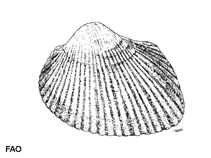Scapharca cornea (Reeve, 1844)
Corneous ark| Native range | All suitable habitat | Point map | Year 2050 |

|
| This map was computer-generated and has not yet been reviewed. |
| Scapharca cornea AquaMaps Data sources: GBIF OBIS |
Classification / Names Common names | Synonyms | CoL | ITIS | WoRMS
Bivalvia | Arcida | Arcidae
Environment: milieu / climate zone / depth range / distribution range Ecology
Benthic; depth range 0 - 20 m. Tropical, preferred 18°C (Ref. 107945)
Distribution Countries | FAO areas | Ecosystems | Occurrences | Introductions
Western Pacific. Introduced in the Black Sea.
Length at first maturity / Size / Weight / Age
Maturity: Lm ? range ? - ? cm Max length : 6.0 cm TL male/unsexed; (Ref. 348); common length : 4.0 cm TL male/unsexed; (Ref. 348)
Short description Morphology
Shell thick and solid, inflated, inequilateral, somewhat transversally elongate in shape and with height greater than inflation, roughly quadrate to trapezoidal in outline; slightly inequivalve, left valve slightly overlapping right valve along posteroventral margin. Anterior margin rounded, ventral margin widely convex and meeting the oblique posterior margin at a blunt angle. Umbones moderately prominent, situated well anterior to midline valves. Posterodorsal slope flattened to slightly concave toward posterior end of dorsal margin, set off by a broad rounded ridge radiating from the umbones to posteroventral end of shell. Cardinal area rather narrow and elongated. About 28 radial ribs (26 to 30) at each valve, as wide as the interstices, mainly granulated on left valve. Periostracum well developed, concentrically striated, scaly to spiky in the interstices of ribs. Internal margins with strong crenulations corresponding with the external radial ribbing. No byssal gape. Colour: outside of shell white, frequently tinged deep bluish green posteriorly; periostracum dark greyish brown. Interior whitish.
Life cycle and mating behavior Maturity | Reproduction | Spawning | Eggs | Fecundity | Larvae
Members of the class Bivalvia are mostly gonochoric, some are protandric hermaphrodites. Life cycle: Embryos develop into free-swimming trocophore larvae, succeeded by the bivalve veliger, resembling a miniature clam.
Main reference
References | Coordinator | Collaborators
Poutiers, J.M. 1998. (Ref. 348)
IUCN Red List Status (Ref. 130435: Version 2024-1)
CITES status (Ref. 108899)
Not Evaluated
CMS (Ref. 116361)
Not Evaluated
Threat to humans
Harmless
Human uses
Fisheries: commercial
FAO - Fisheries: landings | FishSource | Sea Around Us
Tools
More information
Trophic Ecology
Food items
Diet
Food consumption
Ration
Predators
Diet
Food consumption
Ration
Predators
Ecology
Population dynamics
Life cycle
Distribution
Human Related
Aquaculture profile
Stamps, Coins Misc.
Stamps, Coins Misc.
Outreach
References
Internet sources
BHL | BOLD Systems | CISTI | DiscoverLife | FAO(Fisheries: ; publication : search) | Fishipedia | GenBank (genome, nucleotide) | GloBI | Gomexsi | Google Books | Google Scholar | Google | PubMed | Tree of Life | Wikipedia (Go, Search) | Zoological Record
Estimates based on models
Preferred temperature
(Ref. 115969): 17.6 - 29.2, mean 28.3 (based on 1849 cells).
Resilience
(Ref. 69278):
High, minimum population doubling time less than 15 months (K=0.37).
Price category
(Ref. 80766):
Unknown.
Nutrients : Calcium = 149 [71, 228] mg/100g; Iron = 8.53 [1.95, 15.11] mg/100g; Protein = 9.88 [8.64, 11.12] %; Omega3 = 0.313 [0.202, 0.423] g/100g; Selenium = 61 [50, 72] μg/100g; VitaminA = 0 μg/100g; Zinc = 2.04 [0.56, 3.51] mg/100g (wet weight); based on nutrient studies.



